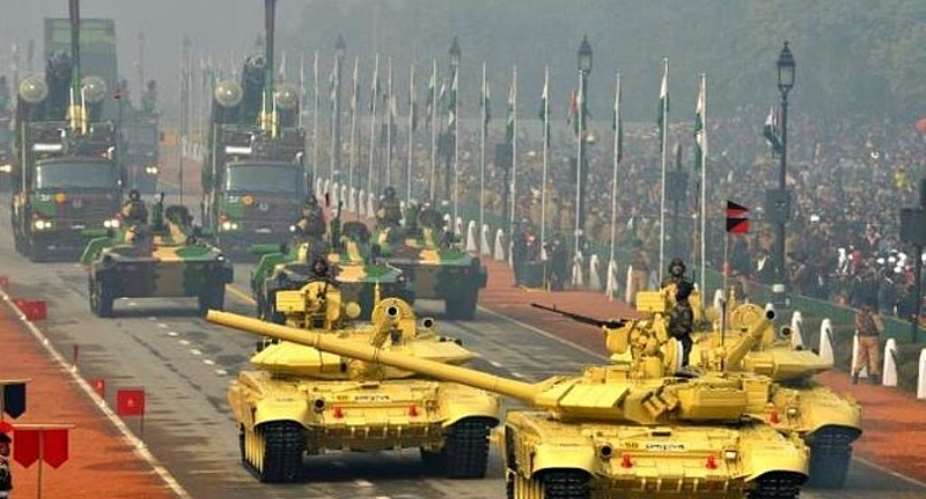In a big push for domestic industry, India will ban imports of more than 100 types of military equipment in pursuit of Prime Minister Narendra Modi's goal of greater self-reliance.
India's defence minister Rajnath Singh announced a list of 101 items that the country will stop importing for its armed forces and will only procure all of these from domestic manufacturers.
So why is India banning imports?
For years India has been among the top three defence importers in the world. The government wants to reduce the dependence on imported items in defence and give a shot in the arm to the domestic defence manufacturing industry.
“This is a big step towards self-reliance in defence,” Singh said on Twitter. “This decision will offer a great opportunity to the Indian defence industry to manufacture the items. . . to meet the requirements of the armed forces.”
From simpler items to advanced technologies, the items mentioned in the negative imports list include water jet fast attack craft to survey vessels, pollution control vessels, light transport aircraft, GSAT-6 terminals, radars, unmanned aerial vehicles, to certain rifles, artillery guns, bullet proof jackets and missile destroyers.
Last month, India had accelerated domestic and foreign purchase of weapons in the wake of a border clash between Indian and Chinese troops. The Defence Acquisition Council had then approved a collection of arms procurement projects worth $5.55 billion, including domestic efforts worth $.4.44 billion.
France, which delivered five of the 36 Dassault Rafale fighter jets to the Indian Air Force worth nearly €8 billion has been one of India's steadfast materiel suppliers for decades.
Defence analysts and experts pointed out that defence collaborations will continue despite the new order and the emphasis was not to be reliant on imported equipment in the list announced.
“The plant built under the Dassault Aviation and Reliance joint venture will enable, for example, the complete production of the Falcon 2000 business jet here in India by 2022,” said India's ambassador to France Emmanuel Lenain in a recent article.
Lenain underscored France's commitment to support India's 'Make in India' enterprise in the defence sector.
“After the delivery of the first two Scorpene submarines, transfers of technology provided by the Naval Group enabled MDL to be solely in charge of building the next four submarines,” he said.
World's second largest importer
According to the Stockholm International Peace Research Institute think tank, India remained the world's second largest arms importer during the period 2015-19 after Saudi Arabia. This included the procurement of fighter jets, transport aircraft, helicopters and howitzers to modernize its defence forces.
SIPRI pointed out that arms imports from Israel and France increased, by 175% and 715% respectively, making them the second- and third-largest suppliers during 2015-2019.
“France has notched up sales worth billions, which other than combat aircraft include light utility helicopters, submarines and missile systems,” writes defence expert Rahul Bed in 'The Wire'.
“French defence companies have also forged lucrative collaborative ventures with Indian public sector undertakings to develop and manufacture a range of engines, to successfully power an assortment of locally designed helicopters.”
The list of weapons banned for import by India will be reviewed every year and more items will be added to it after discussions with the department of military affairs.
This implies India will have to compulsorily develop technology for the defence systems and platforms figuring on the negative import list.





 Dumsor: Don't rush to demand timetable; the problem may be temporary — Atik Moha...
Dumsor: Don't rush to demand timetable; the problem may be temporary — Atik Moha...
 Space X Starlink’s satellite broadband approved in Ghana — NCA
Space X Starlink’s satellite broadband approved in Ghana — NCA
 2024 election will be decided on the grounds of the economy; choice of running m...
2024 election will be decided on the grounds of the economy; choice of running m...
 Dumsor: We're demanding less; just give us a timetable — Kwesi Pratt to ECG
Dumsor: We're demanding less; just give us a timetable — Kwesi Pratt to ECG
 Do I have to apologise for doing my security work, I won’t – Simon Osei-Mensah r...
Do I have to apologise for doing my security work, I won’t – Simon Osei-Mensah r...
 All my businesses have collapsed under Akufo-Addo — NDC Central regional chair
All my businesses have collapsed under Akufo-Addo — NDC Central regional chair
 Military, Prison Officers clash in Bawku, three injured
Military, Prison Officers clash in Bawku, three injured
 GRA-SML contract: MFWA files RTI request demanding KPMG report
GRA-SML contract: MFWA files RTI request demanding KPMG report
 Court threatens to call second accused to testify if NDC's Ofosu Ampofo fails to...
Court threatens to call second accused to testify if NDC's Ofosu Ampofo fails to...
 Family accuses hospital of medical negligence, extortion in death of 17-year-old...
Family accuses hospital of medical negligence, extortion in death of 17-year-old...
